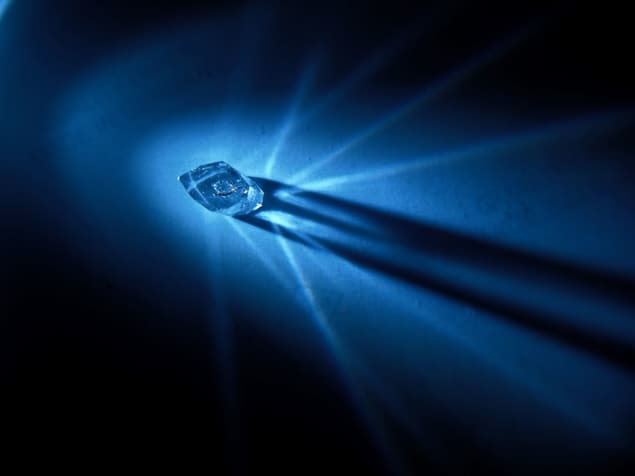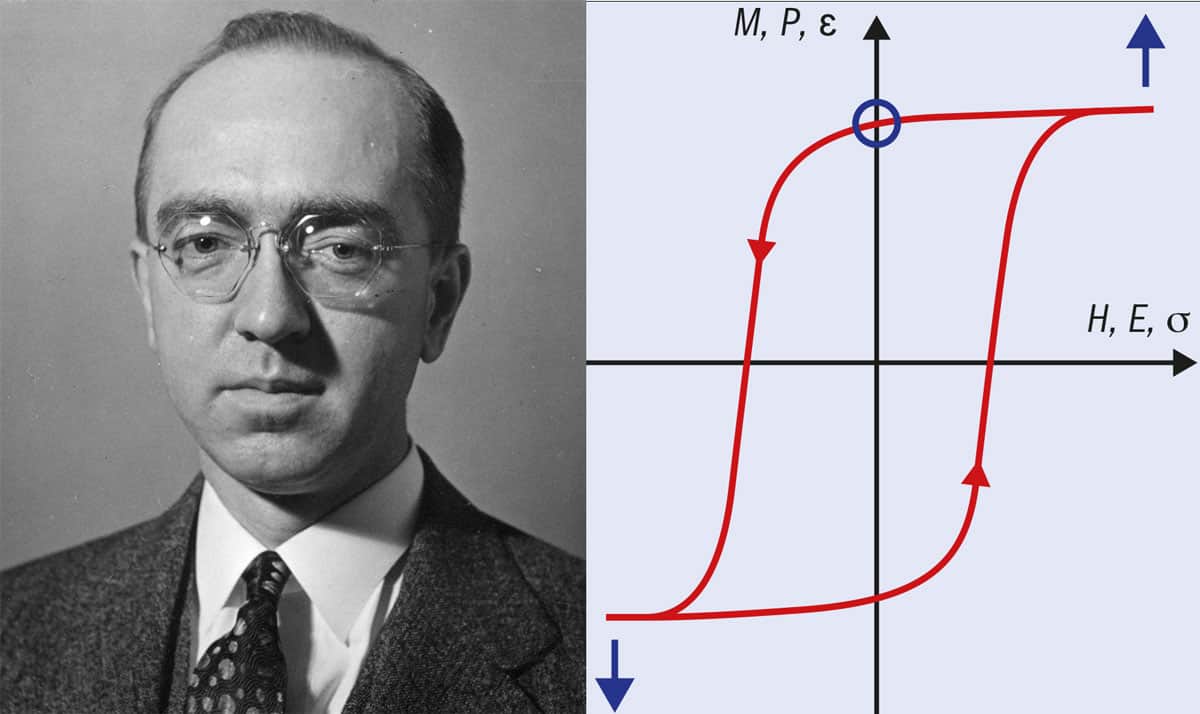When a PhD student called Joseph Valasek discovered ferroelectricity exactly 100 years ago, few people realized the enormous impact it would have on science and technology. Amar S Bhalla and Avadh Saxena pick their favourite applications of this fundamental physics phenomenon

Great discoveries are sometimes made without anyone realizing quite how important they will be. C V Raman, for example, won the Nobel Prize for Physics in 1930 for discovering that light can change energy when it scatters, yet Raman spectroscopy did not become a valuable research tool until well after the laser was invented in 1960. Similarly, few could have imagined that Paul Dirac’s far-fetched yet bold proposal of antiparticles – for which he won the 1933 Nobel prize – would lead to positron emission tomography half a century later.
But there is a lesser known – yet important – discovery that also went largely unrecognized at the time. It was made 100 years ago in 1920 by Joseph Valasek (1897–1993), who was then a graduate student working under the supervision of William Swann at the University of Minnesota, Minneapolis, US. Seeking to develop a seismograph to measure the vibrations from earthquakes, Valasek wondered if this could be done with piezoelectric crystals, which create an electric signal when squeezed.
The most readily available piezoelectric he had at hand was a single-crystalline substance first synthesized in the 17th century by Pierre Seignette, a pharmacist from the French seaport of La Rochelle. Extracted from wine, it became known as Rochelle salt or Seignette salt and has the chemical formula potassium sodium tartrate tetrahydrate (KNaC4H4O6·4H2O). When Valasek placed a sample of this material in an electric field, E, he noticed that its resulting electric polarization, P, did something unusual.
As he turned up the field, the polarization increased, with the graph of P versus E following an S-shaped curve. However, when the field was lowered again, the polarization was always higher than before albeit following the same kind of curve. In other words, the precise value of the polarization depended on whether the field was rising or falling: it was showing hysteresis (figure 1). So unusual was this observation that Swann presented it at the April 1920 meeting of the American Physical Society in Gaithersburg, Maryland, in a paper entitled “Piezoelectric and allied phenomena in Rochelle salt”. (As a lowly PhD student, Valasek did not even attend the meeting.)
Swann and Valasek did not know what caused the hysteresis, but there were parallels with a discovery that had been made three decades earlier by the Scottish physicist James Alfred Ewing. He had seen a similar kind of behaviour in certain ferromagnets, noticing that the magnetic moment depends on how the magnetic field has changed. Valasek’s discovery therefore pointed to an entirely new class of materials, in which the electric dipole moment – and hence the polarization – depends on how the electric field has changed.

Steady success
Now called “ferroelectrics”, these materials have some amazing applications in modern life (see “Applications of ferroelectrics: five of the best”). However, neither Swann nor Valasek had heard of the term, which had been coined in 1912 by Erwin Schrödinger after predicting that certain liquids can spontaneously polarize when they solidify. What’s more, Valasek’s discovery went largely unnoticed. Despite him writing four papers about his observations in Physical Review between 1921 and 1924 with a further note in Science in 1927, no attempts were made to establish the theoretical basis for this phenomenon throughout the entire 1920s.
Most physicists, it seems, were more interested in quantum physics and other fundamental phenomena like Bragg diffraction and Raman spectroscopy. Indeed, it was not until the late 1930s that anyone actually used the word “ferroelectricity” again in the literature. Research only really took off after the future Nobel-prize-winning physicist Vitaly Ginzburg wrote a classic paper on the subject in 1946, though even he called it the “Seignettoelectric” effect given that it had been first observed in Seignette salt.
The field was also boosted by the discovery during the Second World War of another ferroelectric material: barium titanate (BaTiO3). Unlike Rochelle salt, it is insoluble in water, chemically stable at room temperature, and has much better electrical and mechanical properties. Barium titanate was therefore a perfect material for high-energy-density capacitors, although it was only after the war that researchers realized it was ferroelectric with a tell-tale hysteresis in its electrical properties.
Theorists now began to develop a proper understanding of the behaviour of ferroelectrics, helped by experimentalists who started carrying out careful crystallographic analyses of the structure of these materials. By the end of 1950s, several hundred different oxide-based ferroelectric materials – belonging to about 30 different structural families – had been discovered, with physicists testing their electrical properties and weighing up their potential for novel device applications.
One consequence of this systematic study of ferroelectrics came in 1968 when researchers such as Keitsiro Aizu from the Hitachi Central Research Laboratory in Tokyo, Japan, predicted that there could be a similar hysteresis-like relationship between a material’s elastic strain and its applied stress. Dubbed “ferroelastics”, some of these materials are unusual in that if you cool them below a specific temperature and then mechanically distort them, they’ll recover their original shape if you heat them back up again.
These ferroelastics, in other words, “remember” their original physical and geometric shape. They include “shape-memory alloys” such as nickel-titanium, which is widely used for actuating and positioning devices, while others are used in everything from electric cables on the ocean floor to bendable spectacle frames. Ferroelastics are even used in space to form antennas and other gadgets that can be folded up and then unfurled when heated up.
Meet the family
By the late 1960s, physicists therefore knew of three families of materials that all showed hysteresis: ferroelectrics, ferromagnets and ferroelastics. What they all have in common is that neighbouring crystalline domains have a particular property “pointing” in opposite directions (electric dipole for ferroelectrics, magnetism for ferromagnets, and strain for ferroelastics) that can be “switched” with an external field so they all point in the same direction. Indeed, Ginzburg – and another future Nobel laureate, Lev Landau – were able to explain the behaviour of all three types by a single, simple, phenomenological theory.
Some scientists even started grouping the materials under the common banner of “ferroics” – a name that stuck in the literature despite many of the substances not actually containing any iron. Indeed, in the 1970s a fourth family of ferroic materials, known as “ferrotoroidics”, was also discovered, which have a hysteresis in the toroidic field (the cross product of the electric and magnetic field). Including materials such as lithium cobalt phosphate (LiCo(PO4)3) they have magnetic vortices in neighbouring domains that can be made to line up.
And if that was not enough, researchers have also found materials that combine more than one ferroic property either in a single phase or as a composite structure. Known as “multiferroics”, they include “magnetoelectric” materials in which the magnetization can be controlled by an electric field and the polarization can be manipulated by a magnetic field (something that Pierre Curie had suggested as far back as 1894). Such materials can, for example, measure the picotesla-sized magnetic fields from human neurons at room temperature.
What’s most interesting about ferroelectrics is that such materials are also piezoelectric (generating electricity when stressed) and pyroelectric (generating electricity when subject to a variation in temperature). These unique properties have led to ferroelectrics being used in many applications from high-energy-density capacitors and night-vision devices to ultrasound medical equipment, smart technologies for energy harvesting, and actuators and translators. You’ll even find ferroelectrics in burglar alarms, lighters, and heart-rate and blood-pressure monitors.
The future is ferroelectric
A century after the discovery of ferroelectricity, what started as a niche field of research has grown enormously, with more than 20,000 research papers published on the topic to date, driven by its myriad of applications from the nano- to the macroscopic scale. It has even expanded into biology, with ferroelectric behaviour found to occur, for example, in amino acids and in the wall of the aortic blood vessels in pigs. Ferroelectrics could even be used to make sensors that can replicate many human “multifunctional sensory systems”.
Other interesting developments include exotic materials such as “relaxors” (in which the dielectric response depends on the frequency of the applied field) and “quantum paraelectricity” (in which quantum fluctuations suppress the onset of ferroelectric order). Researchers have also started to study 2D ferroelectrics, with atom-by-atom deposition and first-principles calculations pointing to new kinds of nanoscale devices and sensors that could be particularly useful for studying the human body. After all, skin, hair, nails and many other biological tissues behave as piezoelectrics and ferroelectrics when exposed to an electric field, with piezoresponse-force microscopes already providing quantitative data on human biofunctionality.
Even fundamental physics has not been immune from the power of ferroelectrics, with researchers recently observing exotic topological defects called “polar skyrmions” and “polar hopfions” in ferroelectric materials for the first time. What started out as an innocuous experimental observation by a graduate student a century ago will, we believe, continue to benefit science, technology and life for another 100 years and beyond.
Applications of ferroelectrics: five of the best
High-energy capacitors and efficient energy storage devices

One big benefit of ferroelectric materials is that they have a very high dielectric constant, which means they can store lots of energy. Most capacitors in high-energy-density applications, such as compact batteries, therefore contain ferroelectric materials. And despite behaving as insulators with very high electrical resistance, ferroelectrics also played a key role in the discovery of a new class of materials with zero resistance. Working at IBM’s Zurich research lab in the mid-1980s, the future Nobel laureate physicist Alex Müller was studying perovskites – a group of materials that includes ferroelectrics. By tweaking the composition but maintaining their basic structure, he found that these materials carried current without resistance at about 40 K, while others found similar behaviour at liquid-nitrogen temperatures. So for high-temperature superconductors, we can thank ferroelectrics.
Night-vision technology

Cameras that can “see” at night require materials that generate electric charge in response to variations in temperature. Pyroelectrics, which generate a voltage when heated or cooled, can do the job, but it is better to use ferroelectrics such as triglycine sulphate. They have a much higher “pyroelectric coefficient” and can resolve temperature differences as small as 0.01 K. Infrared radiation from, say, a human body can be focused onto arrays of ferroelectric materials, which absorb the light and turn it into a voltage that can be used to create an image corresponding to the person’s temperature profile. Such cameras are also used in medicine, security and night vision. Zoologists have even used night-vision devices to see animals that they previously thought were extinct, including wild dogs in New Guinea.
Medical ultrasound and underwater acoustics

All ferroelectric materials are piezoelectric, which means they generate an electrical voltage when put under pressure by an object. The voltage can then be used to create an image of the object. However, the pressure doesn’t have to be through direct physical contact: it can also come from sound waves reflected off an object that itself is under stress. Ferroelectrics are therefore widely used in medicine for imaging unborn babies to check how they are growing and developing inside the mother’s womb. A similar principle lies behind the hydrophone: a device that can collect sound waves bouncing off underwater objects, such as schools of fish. Ferroelectrics have also been used to map the topography of the ocean floor – such as in 2014 when they were used to locate Malaysian Airlines flight MH370, which disappeared somewhere in the southern Indian Ocean on a flight from Kuala Lumpur to Beijing.
Actuators and translators
Given that all ferroelectrics are piezoelectric, if you apply an electric field, the material will change dimension along one or more permitted directions as determined by its basic crystal structure. The change in size can be barely a few picometres per volt – but that can still be invaluable. Ferroelectrics such as lead zirconium titanate, for example, are used in atomic force microscopes to see individual atoms in materials and also in scanning tunnelling microscopes, for which Gerd Binnig and Heinrich Rohrer won the 1986 Nobel Prize for Physics. Similar materials can also be found in piezoforce microscopes and magnetoforce microscopes. Indeed, another ferroelectric – lead magnesium niobate/lead titanate – was part of the device that NASA used in 1991 to correct flaws in the mirror on the Hubble Space Telescope. Previously washed-out images, such as of the core of galaxy M100, were now much clearer (compare above left and right).
Energy harvesting

Ferroelectric materials can generate electricity under the influence of an input thrust, meaning that some – such as lead zirconium titanate embedded in a polymer – could be used to harvest the energy from cars and lorries that is otherwise lost as heat or noise. The power that can be generated from such devices is currently relatively small – typically a few milliwatts – based as it is on sheets of polyvinylidene difluoride (PVDF) and their polymer composites. But if we can find cheap ways to scale up the production of devices, we could be on to a winner. Another promising application of energy-harvesting devices is in medicine and biology, where only very small energies are involved. They could be a boon for patients who have been fitted with battery-powered mechanical pacemakers to keep their hearts pumping. If the batteries run out, the only way to replace them is for a surgeon to operate on the patient. But if the batteries could be recharged by the voltage generated in a ferroelectric material directly from the thrust of the heartbeat, such operations would be a thing of the past.




